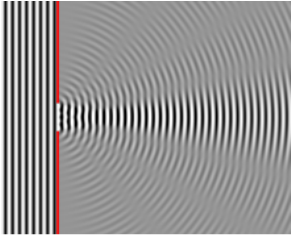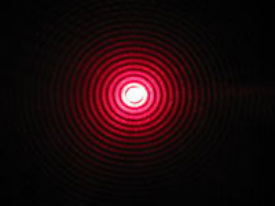If a beam of light is passed through a wide opening, it passes through with little or no diffraction. However, if the opening is small, the wave property of light often produce unusually looking pattern - consisting of bright fringe (called central maximum), the dark fringes and the less-intense bright fringes (called the secondary maxima)
| •HOOK: Teacher reviews Diffraction of waves with the class by asking probing questions like explanation of how diffraction occurs. •ACTION: Teacher discusses single-slit diffraction and the conditions that should exist for it to occur. Fraunhofer diffraction is discussed as a special case of diffraction that shows distinctive differences between the central fringe and darker flanking fringes. •Consolidation: Teacher uses appropriate problem to show how to determine the width of the central maximum of Fraunhofer’s diffraction. |  Fig: Image of Single-slit diffraction Source: http://en.wikipedia.org/wiki/Diffraction  |

